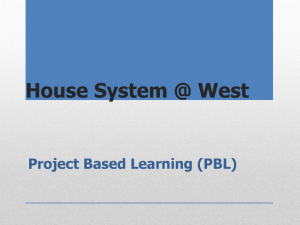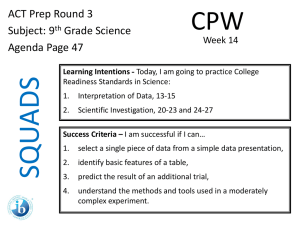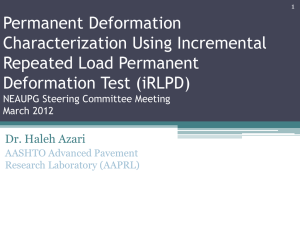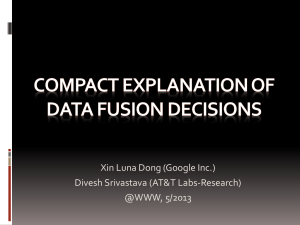Introduction and Overview to Mining Software Repository
advertisement
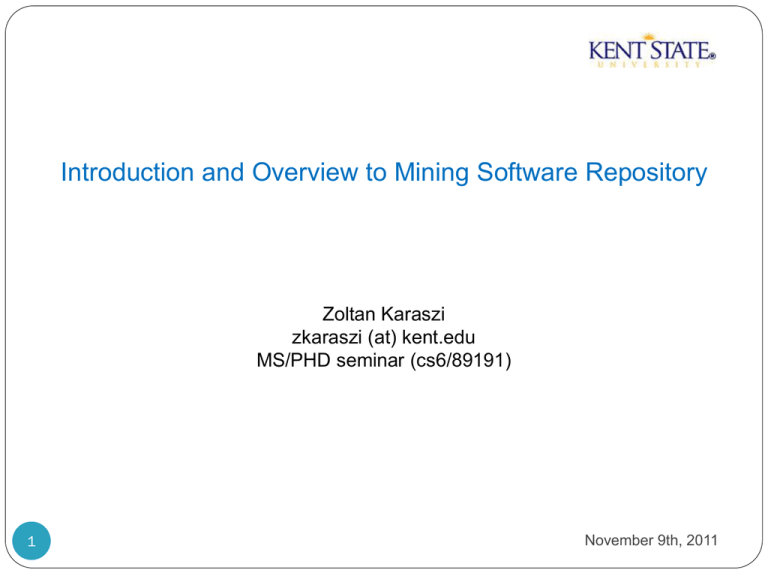
Introduction and Overview to Mining Software Repository Zoltan Karaszi zkaraszi (at) kent.edu MS/PHD seminar (cs6/89191) 1 November 9th, 2011 Abstract Based on the following survey paper: “ A survey and taxonomy of approaches for mining software repositories in the context of software evolution” by Huzefa Kagdi, Michael L. Collard and Jonathan I. Maletic, 2007 After defining MSR, giving background and different classifications, my main goal is - give a general picture about MSR After showing the different MSR approaches I will focus on one example of Frequent-pattern mining that examines the changes and evolution of software 2 November 9th, 2011 Outline 1. Introduction 2. Dimensions of survey 3. A layered taxonomy of MSR 4. Software repository mining overview 5. Example: Frequent-pattern mining 6. Discussion and open issues 7. Concluding remarks 8. References . November 9th, 2011 1. Introduction 1.1. Terms 1.2. Premise 1.3. Scope, background, history 1.4. Goals of the survey . November 9th, 2011 1. Introduction 1.1. Terms Mining Software Repositories (MSRs): created to describe a broad class of investigations into the examination of software repositories Software Repositories (SRs): produced and archived during software evolution Concurrent Versions System (CVS): client-server free software revision control system, track of all changes in a set of files 1.2. Premise Empirical and systematic investigations of repositories Identify uncovered information, relationships or trends Bring new light on the process of software evolution and the changes 3 November 9th, 2011 1.3. Scope, background and history Scope Survey the literature until June, 2006 Specifically investigates evolutionary changes of software artifacts Background No survey of investigation examined the changes and evaluation of software and use data mining and other similar techniques before In the past MSR investigations were subjected on industrial Systems research efforts were limited for few software systems Currently Large increase in open-source software how to manage this challenge 4 November 9th, 2011 1.4. Goals of the survey Form a basis for researchers interested in MSR to better understand the evolution of software systems Create a taxonomy assist in the continued advancement of the field Clearer understanding support the development of tools, methods, processes More precisely reflect the actual nature of software evolution 5 November 9th, 2011 2. Dimensions of survey 2.1. Information sources 2.2. Purpose 2.3. Methodology 2.4. Evaluation . November 9th, 2011 2. Dimensions of the survey 2.1. Information sources Categories of information in SR Metadata about the software change: comments, user-ids, timestamps Differences between the versions: addition, deletion or modification Classification of different software versions (artifacts) Version control systems CVS – doesn’t maintain explicit branch and merge points Subversion (more modern) – build the change-set Bugzilla – bug-tracking system - history of the entire lifecycle of a bug (bug report) 6 November 9th, 2011 2.2. Purpose Extract information and uncover relationships or trends in source code evolution Two classes of answers of MSR questions Market-Basket Question (MBQ) formulated as If A occurs then what else occurs on a regular basis? Prevalence Questions (PQ) formulated as Was a particular function added/deleted/modified? How many and which of the functions are reused? 7 November 9th, 2011 2.3. Methodology Researchers utilize software repositories in multiple ways Limit the studies to the metadata directly available from the repositories using the semantic manner, traditional Use directly the functionality of source code repositories (CVS commands) to get a particular version of the code using the adopted/invented methodology 2.4. Evaluation Assessment metrics Precision: how much of the information found is relevant Recall: how much of all of the relevant information is found 8 November 9th, 2011 3. Layered taxonomy of MSR approaches November 7th, 2011 . 3. Layered taxonomy of MSR approaches All the investigated survey paper works: on version-release histories, on the same level of granularity, ask and answer very similar type of MSR questions, analyze the information and derive conclusions within the context of software evolution The four-layer taxonomic description [1] 9 November 9th, 2011 4. Software repository mining overview 4.1. Metadata analysis 4.2. Static source code analysis 4.3. Source code differencing, analysis 4.4. Software metrics 4.5. Visualization 4.6. Clone-detection methods 4.7. Information-retrieval methods 4.8. Classification with supervised learn 4.9. Social network analysis . November 9th, 2011 4. Software repository mining overview 4.1. Metadata analysis Lightweight methodology to analyze metadata Utilize the metadata stored in software repositories Straightforward first choice – accessible (CVS log) 4.2. Static source code analysis Good approach to extract facts and other information from versions of a system Bug finding and fixing 4.3. Source code differencing and analysis Further extension of MSR with regards to source code changes More source code ‘aware’manner 10 November 9th, 2011 4.4. Software metrics Quantitatively measures various aspects of software products and projects Include size, effort, cost, functionality, quality, complexity and efficiency 4.5. Visualization Interactive visual representation of data to amplify cognition and to support software maintenance and evolution Very task specific Based on the mined data and how one separates approach categories 4.6. Clone-detection methods Approaches for identify both exact and near-miss clones Source code entities with similar textual, structural and semantic composition 11 November 9th, 2011 4.7. Information-Retrieval (IR) methods Classification and clustering of textual units Applied to many software engineering problems Traceability, program comprehension, and software reuse CVS comments, textual descriptions of bug reports, and e-mails 4.8. Classification with supervised learning Supervised learning: technique creating cause–effect function from training data 4.9. Social network analysis For deriving and measuring‘invisible’ relationships between social entities To discover developer roles, contributions, associations in the software development 12 November 9th, 2011 5. Example: Frequent-pattern mining 5.1. Evolutionary couplings and change predictions 5.2. Capabilities of technique 5.3. Extension of their work [33] 5.4. Evaluation 5.5. Advantages of extended ROSE . 18 November 9th, 2011 5. Example: Frequent-pattern mining Discover implicit knowledge from large datasets (patterns, trends, rules) Encompasses IR, statistical analysis and modeling and machine learning Applied to uncover frequently co-change (frequent patterns) software entities Include the ordering information [34] 13 November 9th, 2011 5.1. Evolutionary couplings and change predictions Zimmermann et al. [15] aimed to identify co-occurring changes in a software system Purpose: find changes ? source code entity(function A) modifiedother entities(functions B and C)modified Use ROSE (parser tool) for SC (C++, Java, Python) Association-rule mining technique to determine rules of the form B A Derived association rules such as a particular ‘type’ definition changes leads to changes In instances of variables of that ‘type’ In coupling between interface and implementation 14 November 9th, 2011 5.2. Capabilities of technique Ability to identify addition, modification and deletion of syntactic entities Handles various programming languages and HTML documents Detection of hidden dependencies Figure 1.2: Programmers who Changed this Function also Changed…[15] 15 November 9th, 2011 5.3. Extension of their work [33] Allows prediction of additions to and deletions from entities ROSE was evaluated for Navigation (recommendation of other affected entities) Closure (false suggestions for missing entities) Granularity (fine versus coarse) Maintenance (modified only) 16 November 9th, 2011 5.4. Evaluation (‘interactive power’ of ROSE tool) Period: at least one month selected for eight open-source projects Prediction - based on previous versions: changes occurred during the evaluation New additional measure feedback: percentage of queries Average precision, recall, and feedback values Navigation and prevention support is better with coarse level than with fine level granularity Average feedback values in the case of closure: 1.9% in the case of fine and coarse granularity: 3% 17 November 9th, 2011 5.5. Advantages of extended ROSE tool Needs only a few weeks of history to make suggestions Results can be improved by assigning higher weight to rapid renames and moves Similar approach Ying et al. [34] - approach for source code change prediction at a file level Use: association-mining technique based on FP-tree item-set mining Evaluated: version histories of Mozilla and Eclipse projects 18 November 9th, 2011 6. Discussion and open issues 7. Concluding remarks 8. References . November 9th, 2011 6. Discussion and open issues Need to be able to perform MSR on fine-grained entities Standards for validation must be developed 7. Concluding remarks Over 80 investigations were surveyed Layered taxonomy was derived MSR investigations are promising avenue to help support and understand software evolution ! 19 November 9th, 2011 8. References [1]. Kagdi, H., Collard, M.L., Maletic, J.I., "A Survey and Taxonomy of Approaches for Mining Software Repositories in the Context of Software Evolution", in the Journal of Software Maintenance and Evolution: Research and Practice (JSME), Vol. 19, No. 2, 2007, pp. 77-131. [15]. Zimmermann T, Weißgerber P, Diehl S, Zeller A. Mining version histories to guide software changes. Proceedings 26th International Conference on Software Engineering (ICSE’04). IEEE Computer Society Press: Los Alamitos CA, 2004; [33]. Zimmermann T, Zeller A,Weißgerber P, Diehl S. Mining version histories to guide software changes. IEEE Transactions on Software Engineering 2005; 31(6):429–445. [34]. Ying ATT, Murphy GC, Ng R, Chu-Carroll MC. Predicting source code changes by mining change history. IEEE Transactions on Software Engineering 2004; 30(9):574–586. Thank you for your time ! 20 November 9th, 2011
